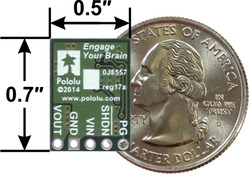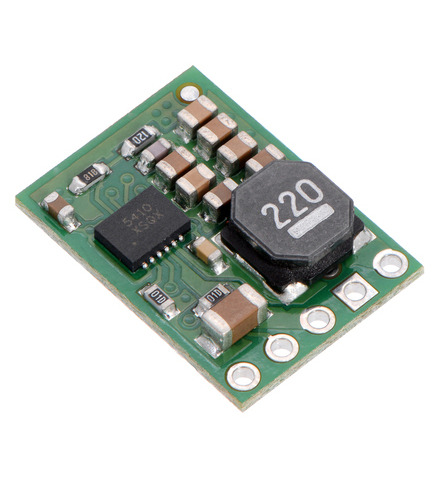Electronics » Regulators and Power Supplies » Step-Down Voltage Regulators »
D24V10Fx Step-Down Voltage Regulators
 |
The D24V10Fx family of step-down voltage regulators features the Intersil ISL85410 1A synchronous buck regulator and generates lower output voltages from input voltages as high as 36 V. They are switching regulators (also called switched-mode power supplies (SMPS) or DC-to-DC converters) with typical efficiencies between 80% and 95%, which is much more efficient than linear voltage regulators, especially when the difference between the input and output voltage is large. These regulators have a power-save mode that activates at light loads and a low quiescent (no load) current draw, which make them well suited for applications that are run from a battery.
The regulators feature short-circuit/over-current protection, and thermal shutdown helps prevent damage from overheating. The boards do not have reverse-voltage protection.
These regulators are available in five different fixed output voltages:
Alternatives available with variations in these parameter(s): output voltage Select variant…
 Compare all products in this category
Compare all products in this category
Products in category “D24V10Fx Step-Down Voltage Regulators”
| Pololu item #: 2830 | |
| Brand: Pololu | supply outlook |
| Status: Active and Preferred | |

|
|
The compact (0.5″ × 0.7″) D24V10F3 synchronous buck voltage regulator takes an input voltage of up to 36 V and efficiently reduces it to 3.3 V while allowing for a maximum output current of 1 A. This regulator offers typical efficiencies between 80% and 90% and has a very low dropout, so it can be used with input voltages as low as a few hundred millivolts above 3.3 V. The pins have a 0.1″ spacing, making this board compatible with standard solderless breadboards and perfboards.
| Pololu item #: 2831 | |
| Brand: Pololu | supply outlook |
| Status: Active and Preferred | |

|
|
The compact (0.5″ × 0.7″) D24V10F5 synchronous buck voltage regulator takes an input voltage of up to 36 V and efficiently reduces it to 5 V while allowing for a maximum output current of 1 A. This regulator offers typical efficiencies between 85% and 90% and has a very low dropout, so it can be used with input voltages as low as a few hundred millivolts above 5 V. The pins have a 0.1″ spacing, making this board compatible with standard solderless breadboards and perfboards.
| Pololu item #: 2832 | |
| Brand: Pololu | supply outlook |
| Status: Active and Preferred | |

|
|
The compact (0.5″ × 0.7″) D24V10F6 synchronous buck voltage regulator takes an input voltage of up to 36 V and efficiently reduces it to 6 V while allowing for a maximum output current of 1 A. This regulator offers typical efficiencies between 85% and 93% and has a very low dropout, so it can be used with input voltages as low as a few hundred millivolts above 6 V. The pins have a 0.1″ spacing, making this board compatible with standard solderless breadboards and perfboards.
| Pololu item #: 2833 | |
| Brand: Pololu | supply outlook |
| Status: Active and Preferred | |

|
|
The compact (0.5″ × 0.7″) D24V10F9 synchronous buck voltage regulator takes an input voltage of up to 36 V and efficiently reduces it to 9 V while allowing for a maximum output current of 1 A. This regulator offers typical efficiencies between 85% and 93% and has a very low dropout, so it can be used with input voltages as low as a few hundred millivolts above 9 V. The pins have a 0.1″ spacing, making this board compatible with standard solderless breadboards and perfboards.
| Pololu item #: 2834 | |
| Brand: Pololu | supply outlook |
| Status: Active and Preferred | |

|
|
The compact (0.5″ × 0.7″) D24V10F12 synchronous buck voltage regulator takes an input voltage of up to 36 V and efficiently reduces it to 12 V while allowing for a maximum output current of 1 A. This regulator offers typical efficiencies between 85% and 93% and has a very low dropout, so it can be used with input voltages as low as a few hundred millivolts above 12 V. The pins have a 0.1″ spacing, making this board compatible with standard solderless breadboards and perfboards.






